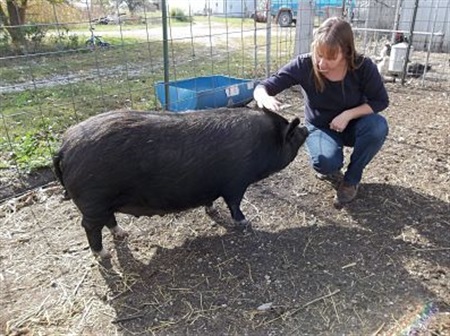
| Posted : | 7/8/2014 |
| Modified : | 11/23/2018 |
| Seller : | eyebuy |
| Phone : | 423-293-0799 |
| Views : | 1389 |
| Price : | $395.00 |
Email Poster About This Ad
We're planning to move off the farm so my hogs have to go. I have 8 total where 4 are full grown (~300-325 lbs). Take these to the butcher shop and sell the sausage or start your herd. Mix it with your venison in sausage. I'm too busy to do it so here's your chance. $395 OBO for all of them. 423-384-1250
Breed: American Guinea Hogs, heritage breed
See stock photo from the internet
Visit: https://guineahogs.org/
https://www.motherearthnews.com/homesteading-and-livestock/raising-pigs/american-guinea-hog-zm0z15onzmat
The American Guinea Hog is a small, black breed of swine that is unique to the United States. Also known as the Pineywoods Guinea and Guinea Forest Hog, the breed was popular for a long period of time in America, but today is nearly extinct. Hogs were imported from West Africa to America in conjunction with the slave trade. The imports were documented as early as 1804 by Thomas Jefferson and other Virginia farmers. These large, square animals were called Red Guineas, because they had red or sandy colored hair. Red Guineas were common throughout the mid-Atlantic region during the 1800′s. The breed disappeared as a distinct population, however, in the 1880′s, when most of the red breeds and types of hogs in the eastern United States were combined to form the Jersey-Duroc breed. The name Guinea occurs again a few decades later in the South-eastern US, though describing a different animal entirely-a small, black hog common on homesteads across the region. Guinea hogs were expected to forage for their own food, eat rodents and other small animals, grass, roots and nuts, and clean out garden beds. The hogs were also kept in the yard where they would eat snakes, and thus create a safe zone around the house. These guineas were hardy and efficient, gaining well on the roughest of forage, and producing the hams, bacon and lard essential for subsistence farming. Guinea hogs were widespread, and descriptions of them varied. Generally, hogs were small, weighing 100-300 pounds, and black or bluish black in color. They had upright ears, a hairy coat and curly tail. Beyond this, conformation varies, as hogs could have short or long snouts, and be “big boned”, “medium boned”, or “fine boned”. It is likely that many strains of Guinea hogs existed. Since most of these are extinct, it is now impossible to weave together all the threads of the guinea hog history into a single neat piece. The guinea hog became rare in recent decades as the habitat of the homestead hog disappeared, and it survived only in the most isolated parts of the Southeast. During the 1980′s, new herds of guinea hogs were established, partly in response to the pet pig market. Several mysteries confuse the breed’s history. The relationship between the historic Red Guinea and the Guinea Hog may be simply the common use of the term “Guinea” to refer to an African origin. “Guinea” may also refer to the small size of the hogs, somewhat akin to the description of miniature Florida Cracker and Pineywoods cattle as “guinea cows”. The guinea hog may or may not be related to the Essex, a small black English breed that was imported into the US around 1820, and used in the development of the Hampshire. Essex hogs were found in the Southeast around 1900, though the breed’s history is obscure. Guinea Essex were used in research at Texas A&M University in the 1960′s, though there is little information available about those hogs. Though the guinea hog would greatly benefit from additional research and description, it is clear that the breed is genetically distinct from improve breeds of hogs and merits conservation. Like other traditional lard-type breeds however, the guinea hog faces great obstacles to it’s conservation. These hogs do not produce a conventional market carcass, since they are smaller and more fatty than is commonly preferred today. Guinea hogs are, however, appropriate for use in diversified, sustainable agriculture. They would be an excellent choice where there is need for services of a hog -such as grazing, rooting, tilling compost and garden soil, and pest control-and also the desire for a small breed. Under such husbandry, Guinea hogs would thrive.



